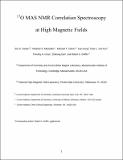| dc.contributor.author | Keeler, Eric George | |
| dc.contributor.author | Michaelis, Vladimir K. | |
| dc.contributor.author | Colvin, Michael Thomas | |
| dc.contributor.author | Hung, Ivan | |
| dc.contributor.author | Gor’kov, Peter L. | |
| dc.contributor.author | Cross, Timothy A. | |
| dc.contributor.author | Gan, Zhehong | |
| dc.contributor.author | Griffin, Robert Guy | |
| dc.date.accessioned | 2020-02-28T19:29:03Z | |
| dc.date.available | 2020-02-28T19:29:03Z | |
| dc.date.issued | 2017-11 | |
| dc.date.submitted | 2017-08 | |
| dc.identifier.issn | 0002-7863 | |
| dc.identifier.issn | 1520-5126 | |
| dc.identifier.uri | https://hdl.handle.net/1721.1/123892 | |
| dc.description.abstract | The structure of two protected amino acids, FMOC-l-leucine and FMOC-l-valine, and a dipeptide, N-acetyl-l-valyl-l-leucine (N-Ac-VL), were studied via one- and two-dimensional solid-state nuclear magnetic resonance (NMR) spectroscopy. Utilizing ¹⁷O magic-angle spinning (MAS) NMR at multiple magnetic fields (17.6–35.2 T/750–1500 MHz for 1H) the ¹⁷O quadrupolar and chemical shift parameters were determined for the two oxygen sites of each FMOC-protected amino acids and the three distinct oxygen environments of the dipeptide. The one- and two-dimensional, ¹⁷O, ¹⁵N–¹⁷O, ¹³C–¹⁷O, and 1H–¹⁷O double-resonance correlation experiments performed on the uniformly ¹³C,¹⁵N and 70% ¹⁷O-labeled dipeptide prove the attainability of ¹⁷O as a probe for structure studies of biological systems. ¹⁵N–¹⁷O and ¹³C–¹⁷O distances were measured via one-dimensional REAPDOR and ZF-TEDOR experimental buildup curves and determined to be within 15% of previously reported distances, thus demonstrating the use of ¹⁷O NMR to quantitate interatomic distances in a fully labeled dipeptide. Through-space hydrogen bonding of N-Ac-VL was investigated by a two-dimensional ¹H-detected ¹⁷O R³-R-INEPT experiment, furthering the importance of ¹⁷O for studies of structure in biomolecular solids. | en_US |
| dc.description.sponsorship | National Institutes of Health (U.S.) (Grant EB-001960) | en_US |
| dc.description.sponsorship | National Institutes of Health (U.S.) (Grant EB-002804) | en_US |
| dc.description.sponsorship | National Institutes of Health (U.S.) (Grant EB-002026) | en_US |
| dc.language.iso | en_US | |
| dc.publisher | American Chemical Society (ACS) | en_US |
| dc.relation.isversionof | http://dx.doi.org/10.1021/jacs.7b08989 | en_US |
| dc.rights | Article is made available in accordance with the publisher's policy and may be subject to US copyright law. Please refer to the publisher's site for terms of use. | en_US |
| dc.source | Prof. Griffin via Erja Kajosalo | en_US |
| dc.title | ¹⁷O MAS NMR Correlation Spectroscopy at High Magnetic Fields | en_US |
| dc.type | Article | en_US |
| dc.identifier.citation | Keeler, Eric G. et al. “¹⁷O MAS NMR Correlation Spectroscopy at High Magnetic Fields.” Journal of the American Chemical Society 139, 49 (November 2017): 17953–17963 © 2017 American Chemical Society | en_US |
| dc.contributor.department | Massachusetts Institute of Technology. Department of Chemistry | en_US |
| dc.contributor.approver | Griffin, Robert Guy | en_US |
| dc.relation.journal | Journal of the American Chemical Society | en_US |
| dc.eprint.version | Author's final manuscript | en_US |
| dc.type.uri | http://purl.org/eprint/type/JournalArticle | en_US |
| eprint.status | http://purl.org/eprint/status/PeerReviewed | en_US |
| dspace.orderedauthors | Keeler, Eric G.; Michaelis, Vladimir K.; Colvin, Michael T.; Hung, Ivan; Gor’kov, Peter L.; Cross, Timothy A.; Gan, Zhehong; Griffin, Robert G. | en_US |
| dspace.embargo.terms | N | en_US |
| dspace.date.submission | 2019-04-04T13:20:46Z | |
| mit.journal.volume | 139 | en_US |
| mit.journal.issue | 49 | en_US |
| mit.license | PUBLISHER_POLICY | en_US |
| mit.metadata.status | Complete | |
